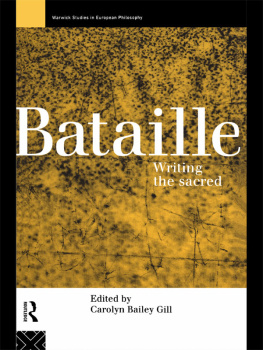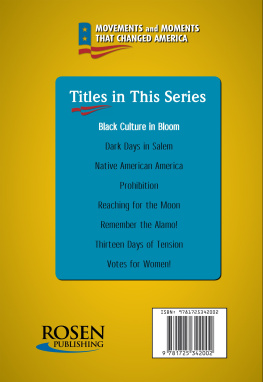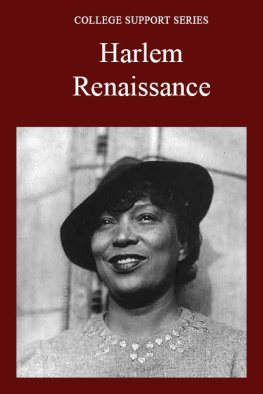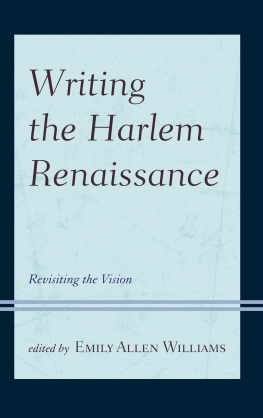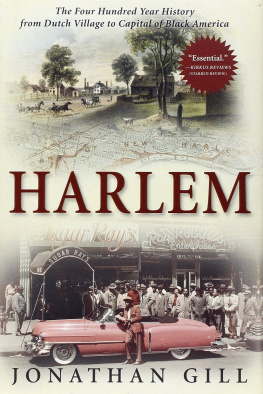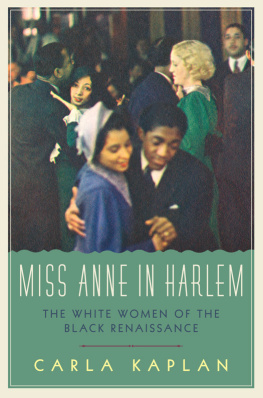HARLEM
HARLEM
THE FOUR HUNDRED YEAR HISTORY
FROM DUTCH VILLAGE TO
CAPITAL OF BLACK AMERICA
JONATHAN GILL

Copyright 2011 by Jonathan Gill
All rights reserved. No part of this book may be reproduced in any form or by any electronic or mechanical means, including information storage and retrieval systems, without permission in writing from the publisher, except by a reviewer, who may quote brief passages in a review. Scanning, uploading, and electronic distribution of this book or the facilitation of such without the permission of the publisher is prohibited. Please purchase only authorized electronic editions, and do not participate in or encourage electronic piracy of copyrighted materials. Your support of the authors rights is appreciated. Any member of educational institutions wishing to photocopy part or all of the work for classroom use, or anthology, should send inquiries to Grove/Atlantic, Inc., 841 Broadway, New York, NY 10003 or permissions@groveatlantic.com
Published simultaneously in Canada
Printed in the United States of America
eBook ISBN-13: 978-0-8021-9594-4
Grove Press
an imprint of Grove/Atlantic, Inc.
841 Broadway
New York, NY 10003
Distributed by Publishers Group West
www.groveatlantic.com
For Eveline Ledeboer
Eisch alles, geef alles
CONTENTS
From Muscoota to Nieuw Haarlem, 16091664
British Harlem, 16641781
Founding an American Harlem, 17811811
The Age of Immigration
The New Negro and the Harlem Renaissance
Harlems Renaissance Comes of Age
The Great Depression Uptown, 19291943
Harlem in the Civil Rights Era, 19431965
Reviving the Renaissance
1
UNRIGHTEOUS BEGINNINGS
From Muscoota to Nieuw Haarlem, 16091664
The first Harlemites didnt quite know what to make of the strange object that sailed up the river in the late summer of 1609. Was it some sort of gigantic flying fish, or a huge swimming bird? And what of the strange, bearded creatures on board? Where did they come from? What did they want? As the earliest residents of the hilly island they called Manahatta would soon learn, the strange object was the Half Moon, a boat belonging to the Dutch East India Company and piloted by the English explorer Henry Hudson. For his part, Hudson seems to have been just as perplexed by the native creatures he saw lining the banks of the waterway they called Mahicanituk, or the River that Flows Both Ways.
Hudson had little time to get to know these people. He was already supposed to be in Asia, and he suspected that the silks and spices of China might lie just upstream. The Half Moon, an eighty-five-foot-long, shallow-bottomed boat suitable for ocean travel as well as for exploration of the uncharted North American rivers that might offer a shortcut to the riches of the Orient, had survived the terrors of the Atlantic crossing, but by the time Hudson first glimpsed what would become the city of New York on September 3, 1609, the vessel had wandered far off course. He anchored for several days at what is now Sandy Hook, in the lower New York bay, and sent a party ashore. There Hudson found the same fertile wilderness that he had seen all along the Atlantic coast that summer, with plenty of food and water for the taking. He also found copper-skinned people with black hair and black eyesthe men beardless, the women tall, all ready to trade and quick with laughter and anger. The encounter turned threatening and one member of the landing party was killed by an arrow while racing back to the Half Moon. Hudson and his crew of twenty pressed on to China.
By September 11, 1609, when the Half Moon entered the mile-wide river, the great streame that would eventually bear its captains name, news of the strange vessel had already reached the indigenous inhabitants of the richly wooded lands just off starboard. Crowds of the natives, including women and children, filled canoes and fearlessly paddled alongside the ship, sensing an opportunity to trade with the crew, offering beans and oysters in return for beads and mirrors. Hudson ordered his men to keep their distance, but the next day he regained his confidence and, as the Half Moon reached the shores of the upper part of the island, he decided to anchor. The next morning, just off an inlet at what is now West 125th Street, a crowd of Indians again approached. At the invitation of Hudson, two climbed on board, staying long enough for Hudson to dress them in red jackets and then try to kidnap them. The two visitors broke free and jumped overboard, mocking Hudson and his crew from shore. The first Harlemites learned early on that white men were not to be trusted.
Hudson continued north, encountering numerous native people over the next eleven days, many of them far less suspicious than those downriver. As the mountains lining either side of the waterway grew higher the natives, who quickly fell under the influence of Hudsons wine, seemed ever more willing to swap their corn and pumpkins for trinkets, tools, or textiles. After a hundred miles it became clear that the narrowing river would not lead to Asia, so the captain turned the Half Moon around and headed downstream, away from the safety of the upper Hudson Valley and back down the river to more unpredictable territory.
On October 2, as the Half Moon passed what is now West 140th Street, the two natives that Hudson had tried to kidnap several weeks earlier led an attack on the ship which, like all East India Company vessels bore a brass tablet fixed to the forecastle reading Do not fight without cause. Hudson now had cause. One of his crewmen wrote: two Canoes full of men, with their Bows and Arrowes shot at us after our sterne: in recompense whereof we discharged six Muskets, and killed two or three of them. The natives were not deterred, and they sent another canoe full of men armed with bows and arrows. Hudsons men continued to fire their muskets, aiming their cannons at the Indians on the banks as well. By the time it was all over the blood of nine more native Harlemites stained the rivers shores.
The encounters between Henry Hudson and the residents of northern Manhattan in 1609 were but a foretaste of Harlems future. The clash of words and worlds, the allure of blood and money, the primacy of violence and fashion, the cohabitation of racial hatred and racial curiositythey have always been part of what uptown means. But from its days as a frontier outpost, to the time when it seemed like the navel of the black universe, to the era when it became the official symbol of poverty in America, Harlem has always been more than a tragedy in the making. Uptowns reputation as the soul of the American century is indisputable. Yet even before the 1920s, when the distinctive beat of Harlems drummers made the whole world march to a new, syncopated rhythm, Harlem featured one of the largest Jewish communities in the world, counting George Gershwin and Harry Houdini as residents. In the nineteenth century, Harlem represented Manhattans future, as city planners built trolley, elevated train, and subway lines uptown in hopes of attracting a middle class that could provide the labor for New Yorks industrial revolution. Before that, John James Audubon, Aaron Burr, and Alexander Hamilton all looked to Harlem for respite from the relentless noise, filth, and danger of downtown Manhattan. In the eighteenth century, George Washington capitalized on his intimate knowledge of the areas topographyhe had unsuccessfully wooed Marthas predecessor there years beforeto defeat the British in the battle of Harlem Heights, one of the key early conflicts of the Revolutionary War. Peter Minuits legendary purchase of Manhattan Island in 1626 took place uptown, not far from the fateful first contacts between Henry Hudson and local Indians in 1609. Through it all, Harlems contending forces of power and protest, intention and improvisation, greed and generosity, and sanctity and suspicion decisively shaped the American character. In that history lies the map of Harlems even more complex future, though the precise contours of the delicate and yet brutal imperatives of the uptowndowntown relationship, of the changing meanings of race and ethnicity, of the swinging dance of social crisis and economic opportunity have yet to be fixed.
Next page




